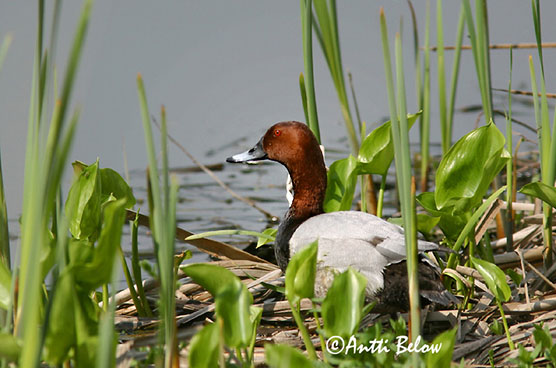Press release 2016-01-25 at 16:30

The common pochard has severely declined due to the decrease of benthic food caused by the eutrophication of water bodies. As a result, the common pochard was re-categorised from vulnerable to endangered. Photo by Antti Below.
The number of threatened bird species increased by 28 species compared to the previous evaluation, while 21 new species were red-listed. Aquatic and wetland species in particular have become increasingly threatened due to the excessive eutrophication of water bodies and other changes in resting areas located along migratory routes and in wintering areas.
Out of the 245 bird species evaluated in 2015, 87 (36% of those evaluated) are threatened, 23 (9%) are near threatened and 135 (55%) are least concern species. Out of the threatened species, 13 (5% of those evaluated) are critically endangered, 36 (16%) are endangered and 38 (16%) are vulnerable. Threatened and near threatened species together comprise the Red List, which thus includes 110 species (45% of those evaluated). The number of threatened bird species increased by 28 species compared to the previous evaluation, while 21 new species were red-listed.
Anseriformes, Accipitriformes and Charadriformes in decline
The proportions of threatened and red-listed species were unevenly distributed among orders of birds. The proportion is higher than the average of all species especially among Anseriformes, Accipitriformes and Charadriformes, whereas the proportion is lower among Strigiformes and Passeriformes.
Examination by main habitat type revealed that the proportion of threatened species was higher than average on shores and in open fell-country, the Baltic Sea and inland waters. Moreover, the proportion of red-listed species was higher than average in mires, though that of threatened species was not. In forests, the proportions of threatened and red-listed species were decidedly lower than the average.
The most important causes for bird species becoming threatened are habitat changes in breeding areas, along migratory routes and in wintering areas. Hunting was also an important cause, but not to that extent in Finland as it was along migratory routes and in wintering areas.
Compared to the previous evaluations conducted in 2000 and 2010, the number of threatened aquatic and wetland bird species in particular increased significantly. Bird species become threatened primarily as a result of the decline of their nesting environments. In inland waters and lush sea bays, excessive eutrophication has also been found to significantly contribute to bird species becoming threatened. In these areas eutrophication has decreased aquatic bird species' access to food due to the clouding of waters and increased competition from growing Cyprinidae populations.
Eagles, the peregrine falcon and the white-backed woodpecker responded positively to conservation
Active conservation efforts have benefited a number of threatened bird species in Finland, particularly the white-tailed eagle, the golden eagle, the peregrine falcon and the white-backed woodpecker, which have all grown in numbers in recent years. Active conservation measures seem to have also successfully halted the decline of the critically endangered southern dunlin. National and international conservation efforts concerning the lesser white-fronted goose are also beginning to bear fruit.
The winter population status of two species wintering in the Baltic Sea, namely the long-tailed duck (least concern) and the Steller's eider (critically endangered), was also evaluated. Other species overwintering in the Finnish Baltic Sea are increasing and were not separately evaluated.
In addition to the national evaluation, the regional evaluation by forest vegetation zones was updated (as in connection with previous evaluations).
Criteria for threatened species
The evaluation of threatened and red-listed bird species in Finland was conducted in 2015 based on the guidelines of the International Union for Conservation of Nature (IUCN), as were the previous evaluations conducted in 2010 and 2000. The evaluation encompassed a total of 248 species, of which 244 underwent an extinction risk assessment. The two Finnish subspecies of the dunlin were evaluated individually, hence the total number of taxa evaluated was 249. For the purpose of the evaluation the two dunlin subspecies were considered to be two different taxa.
Threatened species are species that are at risk of becoming extinct in the future. The assessment of the risk of extinction is based on observed population decline over the course of three generations (varying in length from 10 to 52 years between different species) and/or an extremely small population size. The risk of extinction can be lowered by identifying the causes contributing to it and enacting measures to address them. Threatened species are categorised into different Red List categories based on the rate of population decline or the size of the population. Near threatened species are species that do not quite meet the criteria for threatened species, but may become threatened unless measures are taken to prevent it.
More information
Specialist Researcher Juha Tiainen, Natural Resources Institute Finland (LUKE),
tel. +358 (0)295 327 275, firstname.lastname@luke.fi
Senior Researcher Markku Mikkola-Roos, Finnish Environment Institute (SYKE),
tel. +358 (0)400 148 685, firstname.lastname@ymparisto.fi
Environment Counsellor Esko Hyvärinen, Ministry of the Environment,
tel. +358 (0)295 250 094, esko.o.hyvarinen at ymparisto.fi